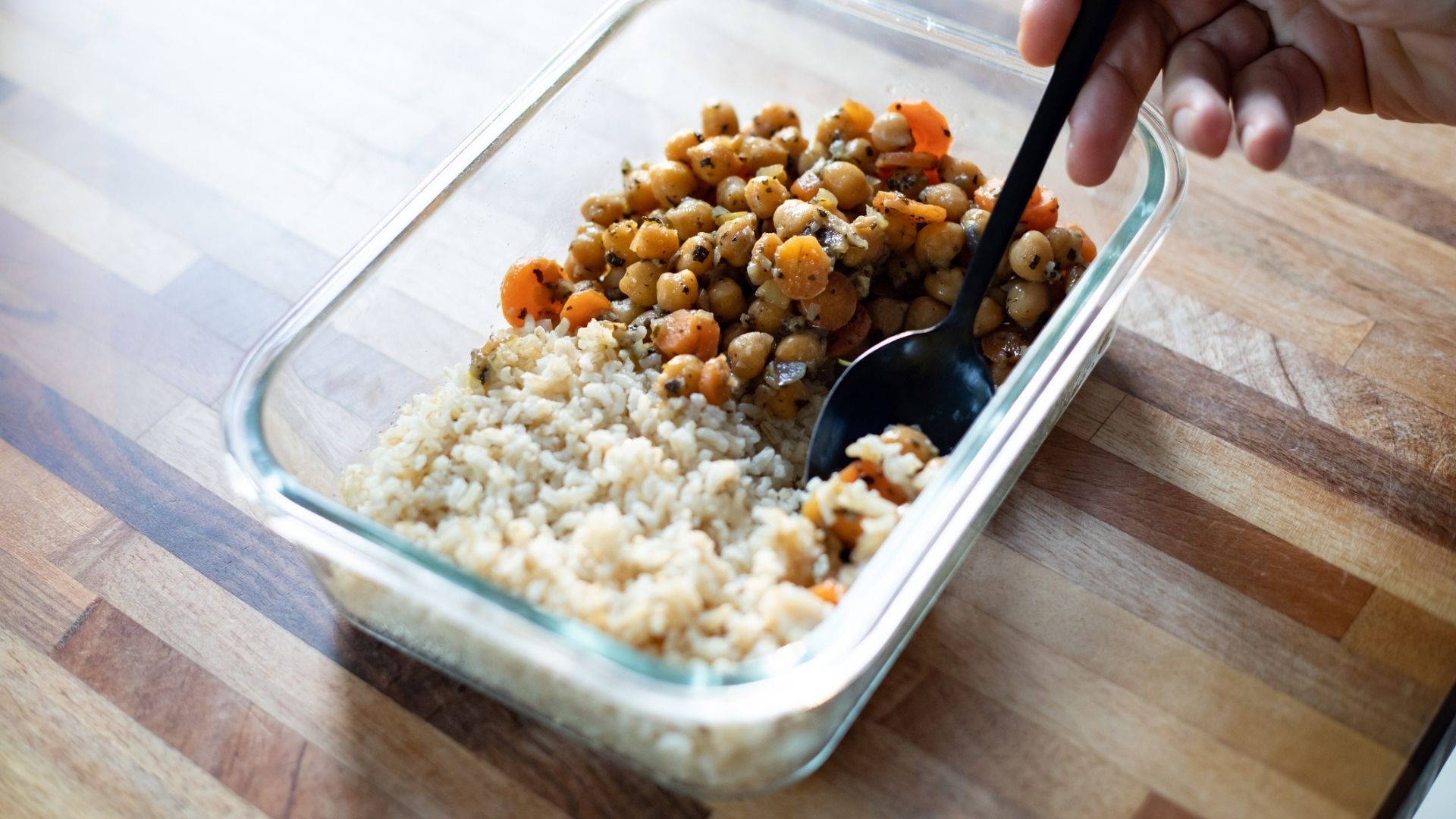How I stuck to a calorie deficit to lose weight—with 9 tips for keeping consistent
Struggling to stick to a calorie deficit to lose weight? Here's how I kept it consistent


Sustaining a calorie deficit to lose weight is taking dieting back to the basics: making sure that you’re eating fewer calories than you’re burning every day. While this may sound like a mammoth task considering the daily NHS-recommended calorie intake for women is 2000 calories, it’s a little bit more complicated than that, which I discovered when I stuck to a calorie deficit for three months.
As I was an active person already, going out for walks and runs after work, I quickly discovered that I had to scrap the idea of 2000 calories per day. Weight loss is personal. What one person’s calorie target is will be different from another. The second thing I learned was that the number of calories you burn completing basic activities like sitting, breathing, and eating is much higher than the number of calories you burn through exercise. So think of exercise as a supplement, for so much more than weight loss, rather than a method through which to do it. And thirdly, while it might be the only way to lose weight physically, orientating all your eating habits around how many calories food contains isn’t all it’s cracked up to be.
These are just three of the things I learned when I decided to get into a calorie deficit to lose weight last year, as just one of the millions of people who took up new cooking routines and workout challenges during the lockdown. While it’s important to remember that losing weight isn’t the be-all and end-all of being healthy, and weighing a certain amount doesn’t contribute to the value of who you are as a person, choosing to change up your habits to lose weight sustainably is a totally valid decision to make.
In total, I kept it up for about three months solidly (with the occasional day off) and lost about seven kg, around one stone. When it comes to creating a calorie deficit and staying in one though, there are a couple of things to consider, from which diet is best to how much exercise to do per week. With the help of Emily Servante, personal trainer and Trainer Education Manager at Ultimate Performance, I’ll unpack everything I learned about how to get into a calorie deficit—and make it worth your while.
How I stayed in a calorie deficit to lose weight
When it comes to losing weight, a calorie deficit is the only method that works. A leading study from the University of Vienna concluded this, after looking at 20 overweight or obese patients following a calorie-restrictive diet alone or with exercise over two months. They found that regardless of which program the patients followed, weight loss was dependent on whether they ate fewer calories than they burned every day.
A new review from Seoul National University Bundang Hospital supports this idea. After laying out the evidence behind each of the most popular diets, including keto and low-fat eating plans, they confirmed that "reducing daily calorie intake is the most important factor for weight loss."
Many of these plans help lower your daily calorie count, but they won't work for everyone as they depend on several factors like current fitness levels and lifestyle habits being suitable. Here are nine tips for staying in your deficit, without a diet plan.
Sign up to our free daily email for the latest royal and entertainment news, interesting opinion, expert advice on styling and beauty trends, and no-nonsense guides to the health and wellness questions you want answered.
1. Logging everything (yes, everything)
While some people choose to monitor their calorie intake without one, I found using a calorie counter app like MyFitnessPal or Lose It to be a pretty essential tool when it came to working out how many calories I was actually eating every day.
But to make the effort of actually logging everything on an app like this worth it, you do really need to log everything. I’m not talking about the 2 calories that make up a shot of espresso. I’m more talking about the 50 calories in the 125ml of oat milk that’s used in a standard flat white coffee, for instance.
Logging calories is a big effort and if you do it for long enough, it's a habit that's difficult to get out of—for better or for worse. But logging everything is the only way to get a mostly-accurate picture of how many calories you’re consuming every day, and can help you lose weight without exercise in many ways.
There are times when you can't, of course, like if you go out to eat where there aren't calories on menus. Tracking calories and trying to lose weight healthily shouldn't stop you from going out to eat at the places you enjoy, so my advice is to make a reasonable guess based on similar dishes elsewhere. The calorie count on menus (and on food packets in general really) is rarely completely accurate down to the last digit anyway.
2. Eating high-protein foods
Tap into one of 2022’s biggest wellness trends and start leveling up your protein intake if you want to lose weight - or even learn how to lose weight without dieting at all. When I was maintaining a deficit, I based each of my meals around a source of protein, whether that was egg, chicken, pulses, or beans. But if you want to get technical about it, the recommended amount is 2.2g to 2.8g of protein per kg of body mass.

What’s the secret behind protein? As a study by the Harvard School of Public Health shows, one of the benefits of protein is that it helps us stay fuller for longer because it’s one of the most filling macronutrients. So as well as feeling like you’ve had a proper meal after eating, you’re less likely to snack later on, adding calories to the final total at the end of the day.
“High protein foods require a lot of energy to digest,” Emily explains. “Think of it this way, if you start a fire and then add some kindling, then it will raise the temperature of the fire, but not by much. But if you put a big log on it, then the flames and the temperature of the fire will shoot up. That’s a good analogy for what is known as the ‘thermic effect' of food. Protein has a very high thermic effect.”
When you eat protein, your metabolism also speeds up because of the energy necessary to digest, process, and absorb all of it, the same study by Harvard explains. “All of which burns calories,” Emily says.
But not only that, losing weight means losing all kinds of weight—not just fat. Protein can change this, however, and help you swap weight loss for fat loss. “Protein encourages the body to tap into fat stores, rather than muscle tissue,” Emily says. “When you’re in a calorie deficit, your body will start to convert those fat stores to give you energy. But particularly if body composition is your goal, a combination of high-protein foods and strength training will signal the body to tap into your fat stores, rather than your muscles.”
You still need to maintain a balanced diet though. "Beyond a certain point, your body will need fats and carbohydrates," she adds.
While you can get most of your protein from natural food sources, supplementing your diet with one of the best protein powders or best protein shakes for losing weight can help you meet your goal.
3. Exercising every day
“Creating a calorie deficit is normally done through a combination of diet and exercise," Emily says. "If you don’t exercise and plan to be in a deficit from diet alone, you will probably have to slash your calories beyond what the body needs to simply maintain its core functions. This isn’t ideal."
“If you plan to simply exercise and not cut back on calories, then you really would need to do a lot of exercise, which isn’t ideal either as your body will be exhausted," she explains. "So, a combination of both diet and exercise is ideal.”

I found that running was the most effective cardio exercise, helping not only to burn calories quickly and improve cardiovascular fitness massively, but it was the biggest endorphin-boosting workout. That's just me, though. The only exercise that will work for you is the one that you enjoy, as you'll actually do it. So whether it's strength training or cold water swimming, just getting out for 30 minutes or an hour's worth of exercise a day can make a huge difference both physically and mentally.
4. Drinking more water
To get the most out of your calorie deficit, drink at least 1.5 liters of water every day. If you’re working out as well, you’ll probably need a lot more than this but this amount works as a good baseline, according to the NHS.
It’s beneficial for many reasons, Emily says, and not drinking enough water is often one of the first weight loss mistakes people make. “Firstly, if you’re dehydrated, it could inhibit your fat loss goals because your body needs that water for almost every single process.”
Secondly, water can also help to bulk out the fiber-rich foods you’ve already eaten. “It will expand your gut and you will feel fuller,” she explains. “It will also put pressure on your stomach lining, which will make you feel fuller.”
5. Making swaps on the basics
Being in a calorie deficit doesn't mean giving up your favorite foods. But if you want to free up more space in your daily amount for higher-calorie foods that you love, it's worth making some basic swaps on foods that you don't care all that much about.
For me, this was swapping:
- Olive oil for one calorie spray, like Frylight
- White potatoes for sweet potatoes
- Dairy milk for 'no sugars' oat or almond milk
- Full-fat mayonnaise and ketchup for low-fat alternatives
- Bread-based breakfasts like toast for oat-based breakfasts, like porridge or overnight oats
On average, I was saving 100 calories a day or more using this method. It's a sustainable way of ensuring that you're still eating all the foods you love but with fewer calories.

6. Trying volume eating
When you get into a consistent calorie deficit, you're going to feel hungry. There's almost no doubt about it. But volume eating, where you eat lots of low-calorie and nutrient-rich foods, is one way to try and stop that from happening.
A study by the University of Leeds looked at almost 100 women who were overweight or obese over 12 weeks. They found that meals with a lower calorie density led to decreased cravings, increased feelings of fullness, and reduced hunger on the whole.
It's partially a psychological thing; you feel like you're eating a lot of food so you feel full. However, you're still eating the same amount or fewer calories than you would in a smaller meal if you prepare it right.
Popular weight loss programs like Weight Watchers use this tactic too. But they position these foods as being worth 'points', so positioning them as 'good' and 'bad' under a budgeting system. This was an idea I couldn't get behind personally. When it comes to a calorie deficit, there's really no such thing as 'good' or 'bad' food, there's just the food that you eat. Whether it's calories from an avocado or a bar of chocolate, it's all worth the same.
High-volume foods include:
- Fruits
- Vegetables, especially non-starchy ones like broccoli and cauliflower
- Wholegrains like quinoa and couscous
- Legumes, including chickpeas, lentils and kidney beans
- Fish
- Poultry, especially chicken
7. Ditching alcohol
This one comes with a huge clause. As someone who drinks on social occasions, I would have found doing this in 'normal' times quite difficult. I enjoy having a glass of wine (or three) with friends and had the option been there for me to do it, I probably would have done so. But I definitely don't think I would have been able to stick to the deficit as easily.
For starters, alcohol contains calories—so that's more adding to your total at the end of the day. Naturally, you can go for the lowest calorie alcohol where possible, with the most popular low-calorie alcoholic drinks including gin and tonic, white wine spritzer, and vodka with soda and lime.
You can navigate these extra calories themselves if you plan though, which might mean swapping out a higher-calorie snack earlier in the day or opting for a lighter breakfast. The biggest issue with alcohol is what happens after you drink it, as a study published in Nature shows that our appetite changes massively after we've had a few drinks.
Researchers discovered that alcohol fires up AgRP neurons in the hypothalamus in the brain, which creates hunger signals. Essentially, despite drinking calorie-heavy drinks, the brain thinks that we're starving. If you're not trying to lose weight then a trip to a takeout after the bar closes won't be a big deal, but if you're trying to stay in a deficit, this will almost certainly be the thing that takes you out of it.

8. Not making the deficit too big
One of the biggest mistakes I made early on with my calorie deficit to lose weight was making that deficit too big. I thought it would offer maximum reward in less time, but actually, all it did was make me hungry all the time. And as a result, I was grouchy and irritated, and I just binged on high-carbohydrate foods or snacks high in saturated fat at the end of the day.
This is to be expected if you go in with a deficit that's too large, Emily confirms. “I would recommend aiming to drop about 1% of your body weight every week. Going beyond this, say to 1.5% or 2% of your body weight, can increase the risk of unhealthy eating behaviors, or increase the risk of losing muscle tissue, or leave you feeling weak and lethargic.”
The best way to find out your ideal calorie deficit is to use a calorie deficit calculator. Using data such as your current weight, height, and goal weight, the calculator will offer your maintenance level and varying levels of deficit you could go into.
“If your calorie drop is too severe then it can also lead to non-adherence, simply because you’re either completely exhausted or your body craves sugar. So, a more moderate calorie deficit is always going to be better to develop sustainable habits.”
9. Being aware that the deficit needs to change
While following a high-protein or Mediterranean diet is a very sustainable way of eating throughout your life because you don’t need to change anything about it for it to work, the deficit you get into at the beginning of your weight loss journey won’t be the same one you need even just a few weeks down the line. Sticking to the same deficit is one of the reasons why many people struggle with not losing weight in a calorie deficit.
Due to my personal weight, height, activity levels, and goals, I started out eating 1,956 calories per day to maintain a deficit of around 500 calories. After three months, I was still eating in this deficit amount but dropped down to 1,836 calories a day.
You have to change up your calorie target for the day because your maintenance calories, the number you need to maintain standard bodily processes, change as you lose weight. It's one of the many reasons that people can be dieting but not losing weight and is typically also one of the biggest intermittent fasting mistakes. “A good example would be that a Range Rover and a Mini have different energy requirements,” Emily says. “A Range Rover needs more petrol than a Mini. Similarly, a bigger person requires more energy than a smaller person. As you get smaller as you diet, your calorie deficit will shrink unless you continually tweak it to your body’s needs.”
Calorie deficit explained
A calorie deficit is when the number of calories you consistently consume daily is less than the number of calories you burn. “There are fat cells all over your body,” Emily explains. “These get either bigger or smaller depending on how much fat you are storing. To send a signal to our body that we need to tap into these fat stores, you need to expend more energy than you put into your body through food and drink.”
This is normally done by reducing the number of calories you eat every day in combination with exercise, she says. “Everyone has a different starting point and everyone has a different maintenance level, which is the number of calories the body needs to consume to maintain its current weight. But, let’s say someone has calorie maintenance of 2000 calories a day. By reducing your calorie consumption by 200-500 calories, you would be in a calorie deficit.”

Grace Walsh is woman&home's Health Channel Editor, working across the areas of fitness, nutrition, sleep, mental health, relationships, and sex. She is also a qualified fitness instructor. In 2025, she will be taking on her third marathon in Brighton, completing her first ultra marathon, and qualifying as a certified personal trainer and nutrition coach.
A digital journalist with over seven years experience as a writer and editor for UK publications, Grace has covered (almost) everything in the world of health and wellbeing with bylines in Cosmopolitan, Red, The i Paper, GoodtoKnow, and more.